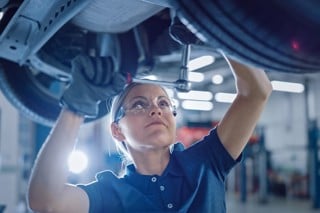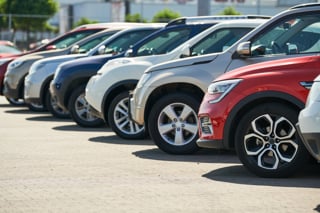Last year, Reg Vardy, one of the UK's biggest dealer groups, created its first ever all-female showroom at its Smart car outlet in Glasgow. Handbags and hairspray may be set to replace aftershave and cuff links, but the most important skills – product knowledge and building customer relationships – sell cars. That's why Toyota retailers have hostesses to greet customers: the carmaker recognises that women tend to have more empathy with the customer, and take a less aggressive stance on making the sale.
The motor industry knows that having a gender-balanced showroom is the way to boost sales volumes. Women influence about 85% of sales and make 52% of all purchases.
The price of the so-called female pound is growing with a generation of enthusiastic drivers who would rather spend cash on their motors than their homes. A survey of nearly 2,000 adults found that 'driving divas' make up almost one-fifth of women motorists, a fact borne out by car sales.
Since 1998, Mercedes-Benz has seen a 63% increase in the number of female owners with 95,375 new cars registered by the end of the first quarter in 2003. Sports cars with strong male ties, such as TVR and Lotus, are also being bought by women drivers. Porsche has seen the number of female owners rise from 1,910 to 3,877 over the past five years.
Make no mistake, these women love their cars. A third would sacrifice saving for the future, put off having a wedding or even starting a family to satisfy their passion for motors. They also read motoring supplements in national papers and follow motorsport. More than half plan to trade in their car for a new one within three years while 16% say they are saving for a luxury sports car, according to a survey for insurer Privilege.
But it's not just the showroom that is undergoing a female revolution. Recent figures show that 143,000 women currently work in the sales, servicing and repair sector of the motor industry, making up almost a quarter (24.5%) of total employees.
Many of the UK's leading car companies and retailers are seeking to increase the number of female staff. BMW wants to attract a higher number of female technicians to its dealer service training programmes. Currently, only one technician in 300 employed in BMW dealerships is female and the German carmaker wants to tap in to the very best potential in the marketplace. It has started to send out information packs to girls' schools and is advertising in women's magazines.
Work has also been done to survey dealerships to ensure they operate an equal opportunities policy. These moves have raised the level of applications from females into sales training programmes, but have been unsuccessful so far with technician training.
Roger Waters, BMW career-planning manager, says the traditional image of the greasy car mechanic needs updating. “Today's cars are more sophisticated with an ever increasing proportion of electronics and widespread use of computerised diagnostic systems,” he says. “When we are searching for the best school leavers to become technicians, it is crazy to ignore half of those young people.” BMW receives 2,000 applications a year for the technician course, but can only accept 150.
It's not just BMW that recognises the importance of expanding its skills base. Land Rover has introduced a Women's Panel into the product development process to ensure the views of female customers are represented. The group, made up of women volunteers from the company, extends across a range of backgrounds to broaden a vehicle's appeal.
But this quiet revolution has yet to be reflected in the public perception of women working in the motor trade. The industry is also sometimes guilty of being its own worst enemy. The SMMT's Motor Show ads in 2002, which displayed a woman in a bra with the line “the other way to your man's heart is down the M6 and off at Junction 4”, were blasted by Trade Secretary Patricia Hewitt as “sexist” and “old-fashioned”.
Sarah Sillars, the Institute of the Motor Industry's first female chief executive, is conscious of the need to encourage more women to join the industry and the potential difficulties they face.
“My job is not just a job – it is a way of life. Two or three evenings a week I have to participate in work-related activities. I could not do my job and lead a normal family life if I didn't have my husband,” she says.
“I believe that until both the working and retail environment becomes more female friendly, we will sadly never get huge amounts of women joining the car industry.”
Sillars' thoughts are echoed by Pauline Wiseman, Honda's head of human resource operations and the person responsible for setting up the Honda Institute training centre. “There is a problem attracting women to the industry but there doesn't have to be – after all it is a people business,” she says.
The problem isn't confined to the automotive sector; women are under represented in all positions of power. According to a report from the Equal Opportunities Commission they make up just 9% of top business leaders.
To the surprise of many, it seems that it is the automotive industry that is starting to buck this trend.

















Login to comment
Comments
No comments have been made yet.